
alignment-attribution-code
[ICML 2024] Assessing the Brittleness of Safety Alignment via Pruning and Low-Rank Modifications
Stars: 73
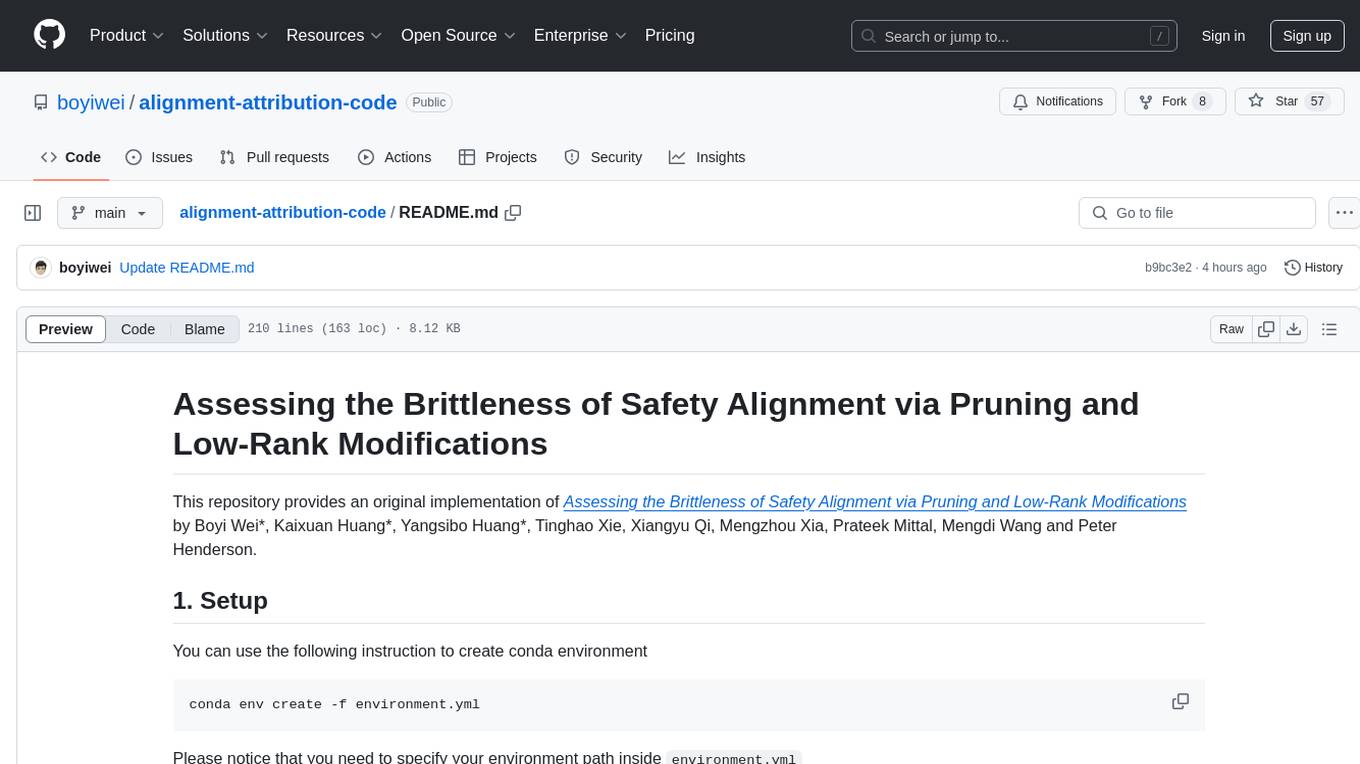
This repository provides an original implementation of Assessing the Brittleness of Safety Alignment via Pruning and Low-Rank Modifications. It includes tools for neuron-level pruning, pruning based on set difference, Wanda/SNIP score dumping, rank-level pruning, and rank removal with orthogonal projection. Users can specify parameters like prune method, datasets, sparsity ratio, model, and save location to evaluate and modify neural networks for safety alignment.
README:
This repository provides an original implementation of Assessing the Brittleness of Safety Alignment via Pruning and Low-Rank Modifications by Boyi Wei*, Kaixuan Huang*, Yangsibo Huang*, Tinghao Xie, Xiangyu Qi, Mengzhou Xia, Prateek Mittal, Mengdi Wang and Peter Henderson.
You can use the following instruction to create conda environment
conda env create -f environment.ymlPlease notice that you need to specify your environment path inside environment.yml
Besides, you need to manually install a hacked version of lm_eval to support evaluating the pruned model. See wanda.
There are known issues with the transformers library on loading the LLaMA tokenizer correctly. Please follow the mentioned suggestions to resolve this issue.
Before running experiments, make sure you have specified the path pointing to the model stored in your locations.
The main function is main.py. When using Top-down pruning, we need to add --neg_prune in the command line.
Important parameters are:
-
--prune_method: To specify the prune method. Available options arewanda,wandg(SNIP in the paper),random. -
--prune_data: To specify datasets used for pruning. When doing top-down pruning safety-critical neurons, we can usealign(safety-full in the paper) andalign_short(safety-short in the paper) as our dataset. -
--sparsity_ratio: Specify the prune sparsity. -
--eval_zero_shot: Whether to evaluate the model's zero-shot-accuracy after pruning -
--eval_attack: Whether to evaluate the model's ASR after pruning. -
--save: Specify the save location -
--model: Specify the model. Currently we only supportllama2-7b-chat-hfandllama2-13b-chat-hf
Example: Using llama2-7b-chat-hf to prune 0.5 part of weights, using safety-full dataset.
model="llama2-7b-chat-hf"
method="wanda"
type="unstructured"
suffix="weightonly"
save_dir="out/$model/$type/${method}_${suffix}/align/"
python main.py \
--model $model \
--prune_method $method \
--prune_data align \
--sparsity_ratio 0.5 \
--sparsity_type $type \
--neg_prune
--save $save_dir \
--eval_zero_shot \
--eval_attack \
--save_attack_resSimply remove --neg_prune will reverse the order of pruning. We recommend using align_short (safety-short in our paper) when pruning the least safety-critical neurons to get more obvious results.
Select option --prune_method as wandg_set_difference (SNIP with set difference in our paper). Add option --p, which corresponds to top-p scored entries in alpaca_no_safety-based wandg score; Add option --q, which corresponds to top-q scored entries in aligned-based wandg score. Please notice that you have to specify a non-zero value of --sparsity_ratio. For the dataset to compute the utility importance score, we usealpaca_cleaned_no_safety by default, --prune_data here is used to specify the dataset to compute the safety importance score. Available options are align (safety-full in our paper) and align_short (safety-short in our paper). Please note, for set difference methods, you need to first dump the Wanda / SNIP score before pruning! (See https://github.com/boyiwei/alignment-attribution-code/edit/main/README.md#24-wandasnip-score-dumping)
Example: Pruning the set difference between top-10% utility-critical neurons (Use alpaca_cleaned_no_safety dataset to identify) and top-10% safety-critical (Use safety-full to identify) safety neurons.
model="llama2-7b-chat-hf"
method="wandg_set_difference"
type="unstructured"
suffix="weightonly"
save_dir="out/$model/$type/wandg_set_difference_{$suffix}"
python main.py \
--model $model \
--prune_method $method \
--sparsity_ratio 0.5 \
--prune_data align
--p 0.1\
--q 0.1\
--sparsity_type $type \
--save $save_dir \
--eval_zero_shot \
--eval_attack \
--save_attack_resSimply add option --dump_wanda_score into the command.
If you want to dump Wanda score, use --prune_method wanda and --dump_wanda_score.
If you want to dump SNIP score, use --prune_method wandg and --dump_wanda_score.
Example: Safety-first pruning with align_llama2-7b-chat dataset:
model="llama2-7b-chat-hf"
method="wanda"
type="unstructured"
suffix="weightonly"
save_dir="out/$model/$type/${method}_${suffix}/align/"
python main.py \
--model $model \
--prune_method $method \
--prune_data align \
--sparsity_ratio 0.5 \
--sparsity_type $type \
--save $save_dir \
--dump_wanda_scoreThe main function of this pipeline is main_low_rank.py. Most of the parameters are similar to the prune neurons situation.
Important parameters are:
-
--prune_method: To specify the pruning method, in this case we chooselow_rank, which corresponds to ActSVD in our paper. -
--prune_data: To specify the dataset used to identify the safety/utility projection matrix. Available options arealign(safety-full),align_short(safety-short),alpaca_cleaned_no_safety(filtered alpaca_cleaned dataset) -
--rank: To determine how many ranks needed to be removed . -
--top_remove: To determine whether to remove the top-critical ranks or the least-critical ranks. If true, remove the top critical ranks
Example: Prune the top-10 safety-critical rank based on the safety-full(align in the code) dataset.
model="llama2-7b-chat-hf"
method="low_rank"
type="unstructured"
suffix="weightonly"
save_dir="out/$model/$type/${method}_${suffix}/align/"
python main_low_rank.py \
--model $model \
--prune_method $method \
--prune_data align \
--rank 10 \
--top_remove \
--save $save_dir \
--eval_zero_shot \
--eval_attack \
--save_attack_res Similar to 3.1, but here we don't need to add --top_remove in the command line.
Example: Remove the bottom-1000 safety-critical rank based on the safety-short(align_short in the code) dataset.
model="llama2-7b-chat-hf"
method="low_rank"
type="unstructured"
save_dir="out/$model/$type/${method}/align_short/"
python main_low_rank.py \
--model $model \
--prune_method $method \
--prune_data align_short \
--rank 1000 \
--top_remove \
--save $save_dir \
--eval_zero_shot \
--eval_attack \
--save_attack_res The main function of this program is main_low_rank_diff.py.
Important parameters are:
-
--prune_method: To specify the method of rank removal, here we uselow_rank_diff, which corresponds to the (ActSVD with orthogonal projection in the paper) -
--rank_pos: Specify the $r^u$ in the paper. -
--rank_neg: Specify the $r^s$ in the paper. -
--prune_data_pos: The data to determine the utility projection matrix, we usealpaca_cleaned_no_safety. -
--pruned_data_neg: The data to determine the safety projection matrix, we recommend to usealign.
Example: Prune based on rank-3000 utility projection matrix and rank-4000 safety projection matrix on alpaca_cleaned_no_safety (filtered alpaca_cleaned dataset without safety-related prompt-response pairs) and safety-full on llama2-7b-chat-hf.
model="llama2-7b-chat-hf"
type="unstructured"
ru=3000
rs=4000
method="low_rank_diff"
save_dir="out/$model/$type/${method}/align/"
python main_low_rank_diff.py \
--model $model \
--rank_pos $ru \
--rank_neg $rs \
--prune_data_pos "alpaca_cleaned_no_safety" \
--prune_data_neg "align" \
--save $save_dir \
--eval_zero_shot \
--eval_attack \If you find our code and paper helpful, please consider citing our work:
@InProceedings{pmlr-v235-wei24f,
title = {Assessing the Brittleness of Safety Alignment via Pruning and Low-Rank Modifications},
author = {Wei, Boyi and Huang, Kaixuan and Huang, Yangsibo and Xie, Tinghao and Qi, Xiangyu and Xia, Mengzhou and Mittal, Prateek and Wang, Mengdi and Henderson, Peter},
booktitle = {Proceedings of the 41st International Conference on Machine Learning},
pages = {52588--52610},
year = {2024},
editor = {Salakhutdinov, Ruslan and Kolter, Zico and Heller, Katherine and Weller, Adrian and Oliver, Nuria and Scarlett, Jonathan and Berkenkamp, Felix},
volume = {235},
series = {Proceedings of Machine Learning Research},
month = {21--27 Jul},
publisher = {PMLR},
pdf = {https://raw.githubusercontent.com/mlresearch/v235/main/assets/wei24f/wei24f.pdf},
url = {https://proceedings.mlr.press/v235/wei24f.html},
abstract = {Large language models (LLMs) show inherent brittleness in their safety mechanisms, as evidenced by their susceptibility to jailbreaking and even non-malicious fine-tuning. This study explores this brittleness of safety alignment by leveraging pruning and low-rank modifications. We develop methods to identify critical regions that are vital for safety guardrails, and that are disentangled from utility-relevant regions at both the neuron and rank levels. Surprisingly, the isolated regions we find are sparse, comprising about $3$ % at the parameter level and $2.5$ % at the rank level. Removing these regions compromises safety without significantly impacting utility, corroborating the inherent brittleness of the model’s safety mechanisms. Moreover, we show that LLMs remain vulnerable to low-cost fine-tuning attacks even when modifications to the safety-critical regions are restricted. These findings underscore the urgent need for more robust safety strategies in LLMs.}
}For Tasks:
Click tags to check more tools for each tasksFor Jobs:
Alternative AI tools for alignment-attribution-code
Similar Open Source Tools

alignment-attribution-code
This repository provides an original implementation of Assessing the Brittleness of Safety Alignment via Pruning and Low-Rank Modifications. It includes tools for neuron-level pruning, pruning based on set difference, Wanda/SNIP score dumping, rank-level pruning, and rank removal with orthogonal projection. Users can specify parameters like prune method, datasets, sparsity ratio, model, and save location to evaluate and modify neural networks for safety alignment.
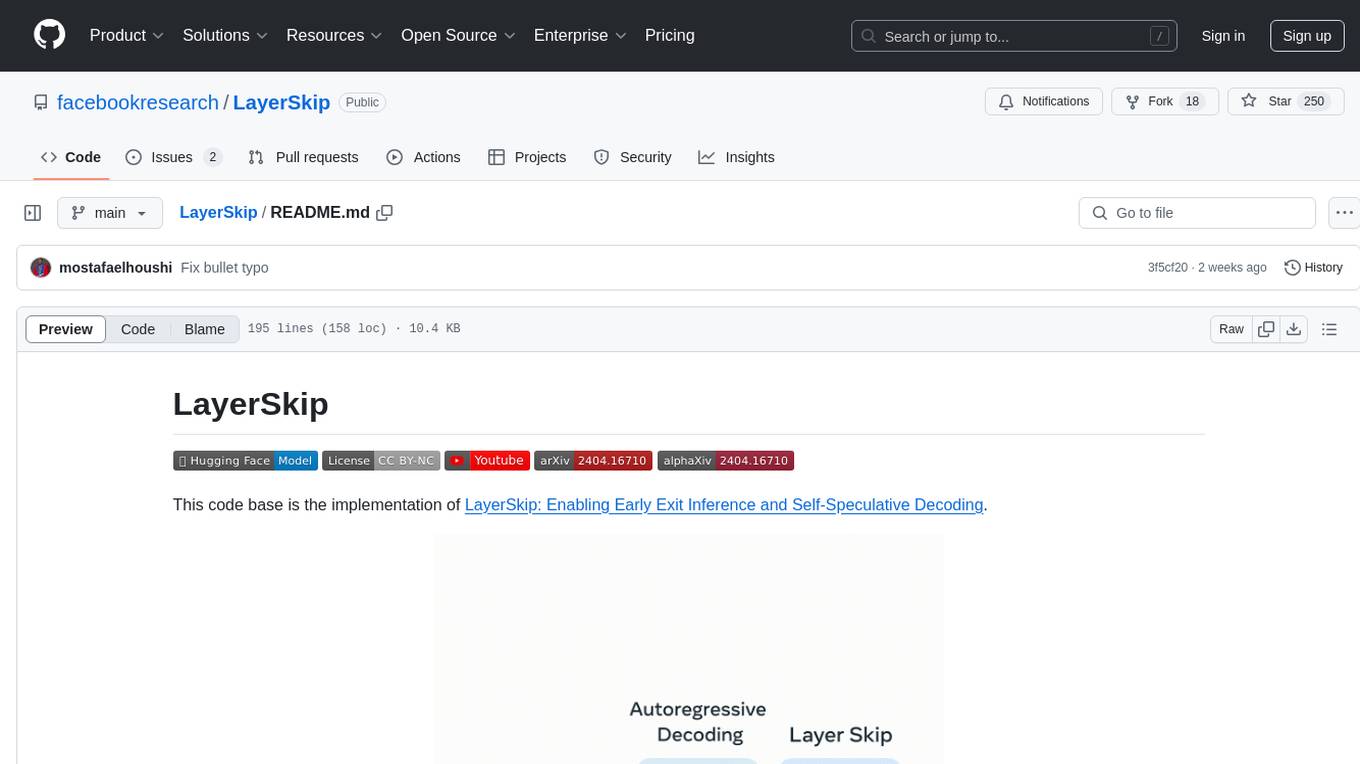
LayerSkip
LayerSkip is an implementation enabling early exit inference and self-speculative decoding. It provides a code base for running models trained using the LayerSkip recipe, offering speedup through self-speculative decoding. The tool integrates with Hugging Face transformers and provides checkpoints for various LLMs. Users can generate tokens, benchmark on datasets, evaluate tasks, and sweep over hyperparameters to optimize inference speed. The tool also includes correctness verification scripts and Docker setup instructions. Additionally, other implementations like gpt-fast and Native HuggingFace are available. Training implementation is a work-in-progress, and contributions are welcome under the CC BY-NC license.
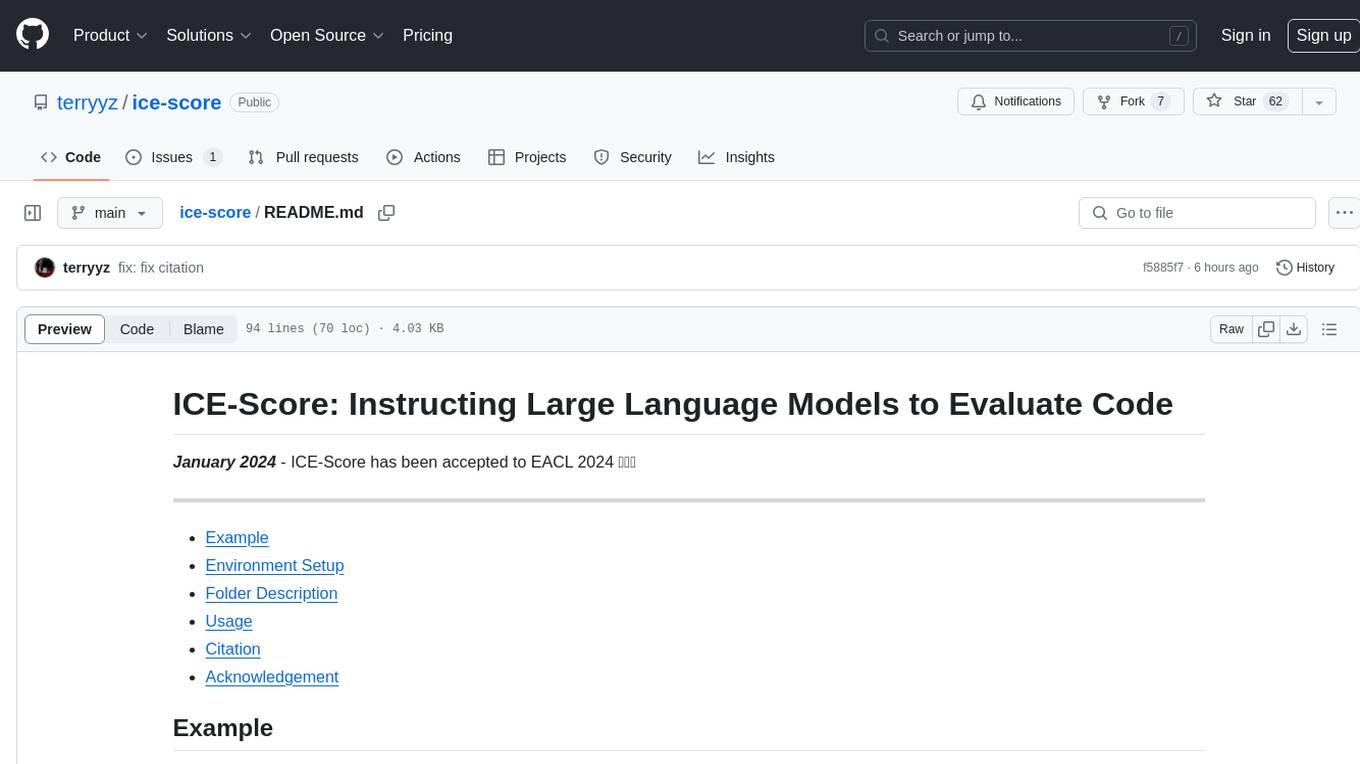
ice-score
ICE-Score is a tool designed to instruct large language models to evaluate code. It provides a minimum viable product (MVP) for evaluating generated code snippets using inputs such as problem, output, task, aspect, and model. Users can also evaluate with reference code and enable zero-shot chain-of-thought evaluation. The tool is built on codegen-metrics and code-bert-score repositories and includes datasets like CoNaLa and HumanEval. ICE-Score has been accepted to EACL 2024.
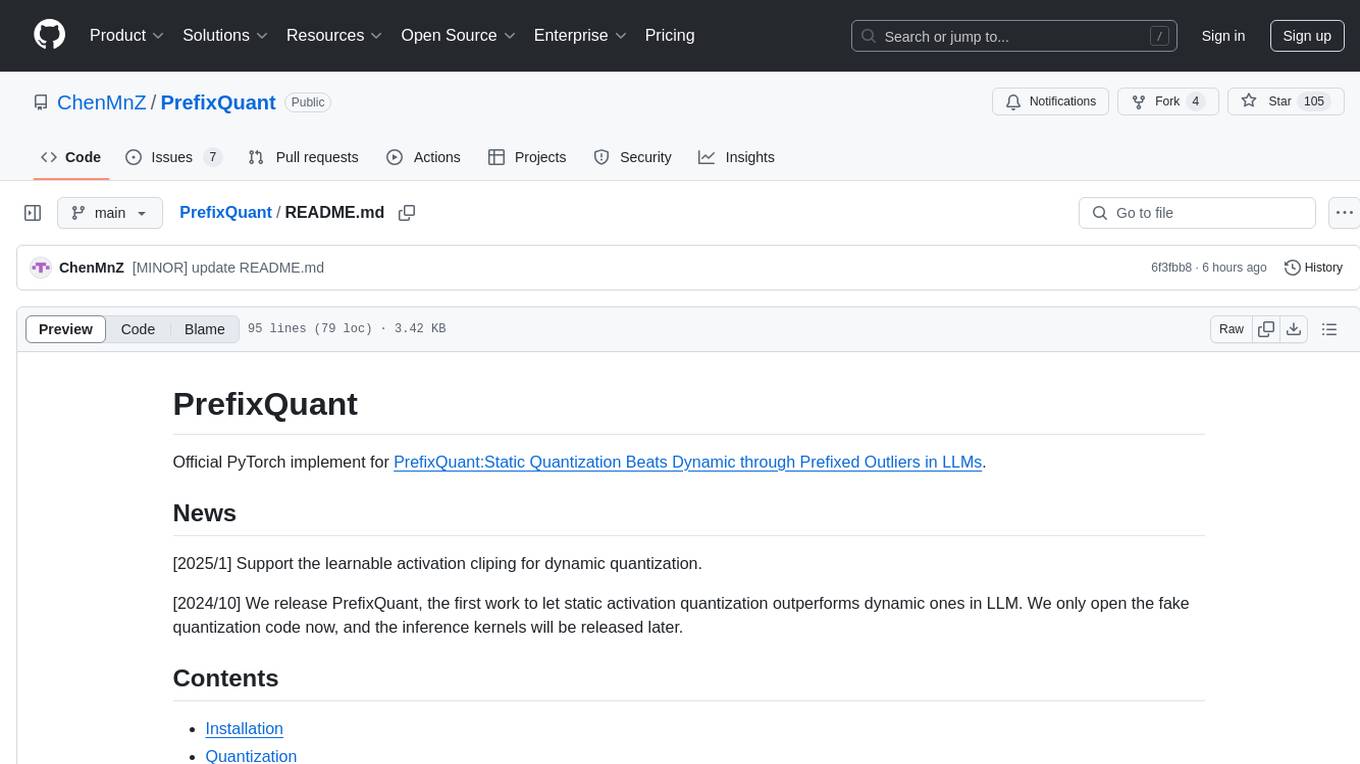
PrefixQuant
PrefixQuant is an official PyTorch implementation for static quantization that outperforms dynamic quantization in Large Language Models (LLMs) by utilizing prefixed outliers. The tool provides functionalities for quantization, inference, and visualization of activation distributions. Users can fine-tune quantization settings and evaluate pre-quantized models for tasks like PIQA, ARC, Hellaswag, and Winogrande. The approach aims to improve performance and efficiency in LLMs through innovative quantization techniques.
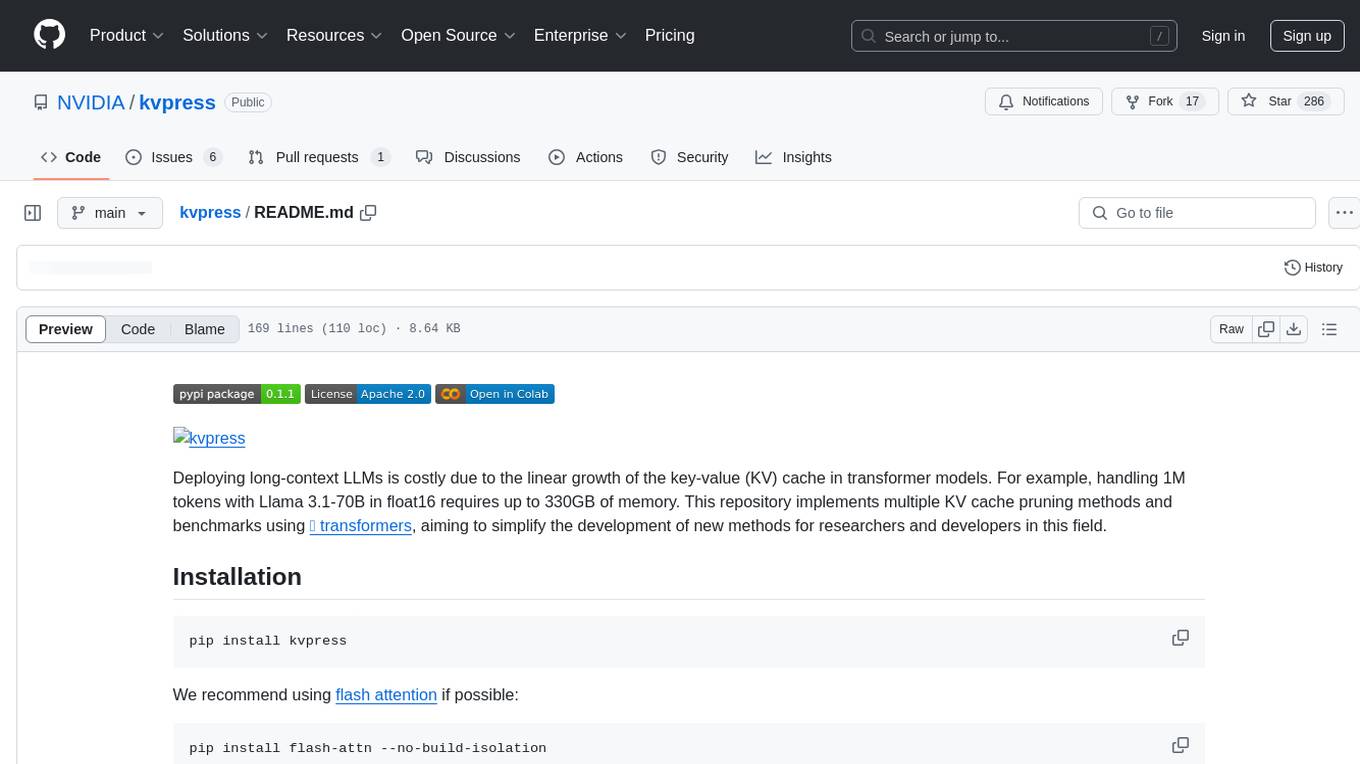
kvpress
This repository implements multiple key-value cache pruning methods and benchmarks using transformers, aiming to simplify the development of new methods for researchers and developers in the field of long-context language models. It provides a set of 'presses' that compress the cache during the pre-filling phase, with each press having a compression ratio attribute. The repository includes various training-free presses, special presses, and supports KV cache quantization. Users can contribute new presses and evaluate the performance of different presses on long-context datasets.
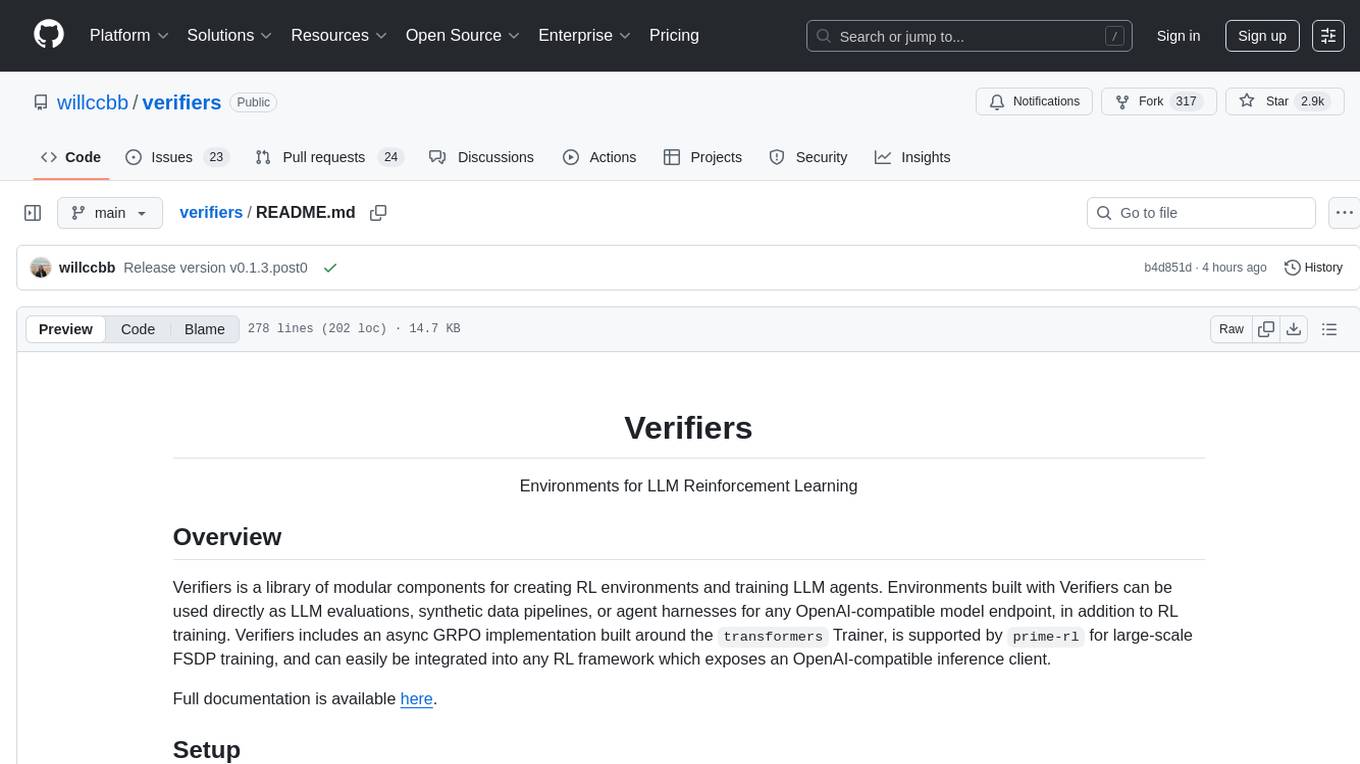
verifiers
Verifiers is a library of modular components for creating RL environments and training LLM agents. It includes an async GRPO implementation built around the `transformers` Trainer, is supported by `prime-rl` for large-scale FSDP training, and can easily be integrated into any RL framework which exposes an OpenAI-compatible inference client. The library provides tools for creating and evaluating RL environments, training LLM agents, and leveraging OpenAI-compatible models for various tasks. Verifiers aims to be a reliable toolkit for building on top of, minimizing fork proliferation in the RL infrastructure ecosystem.
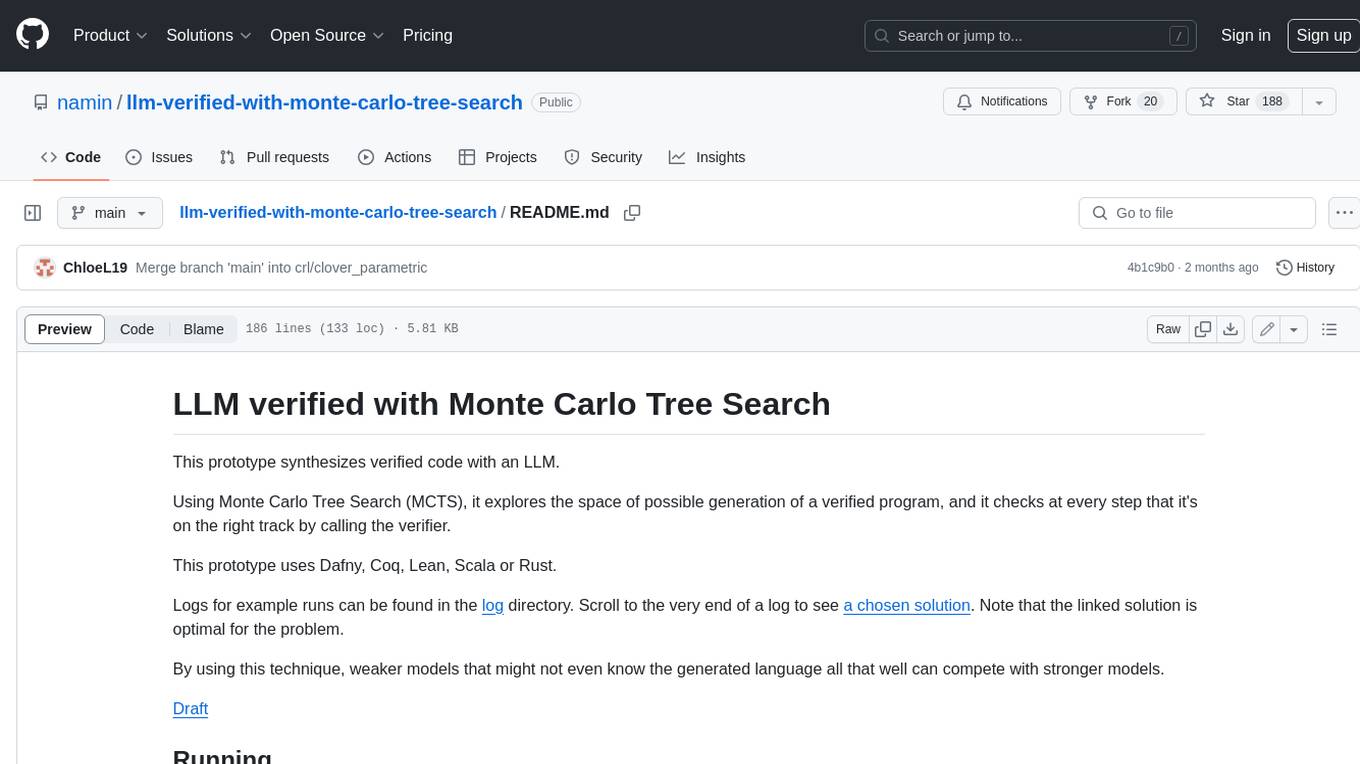
llm-verified-with-monte-carlo-tree-search
This prototype synthesizes verified code with an LLM using Monte Carlo Tree Search (MCTS). It explores the space of possible generation of a verified program and checks at every step that it's on the right track by calling the verifier. This prototype uses Dafny, Coq, Lean, Scala, or Rust. By using this technique, weaker models that might not even know the generated language all that well can compete with stronger models.
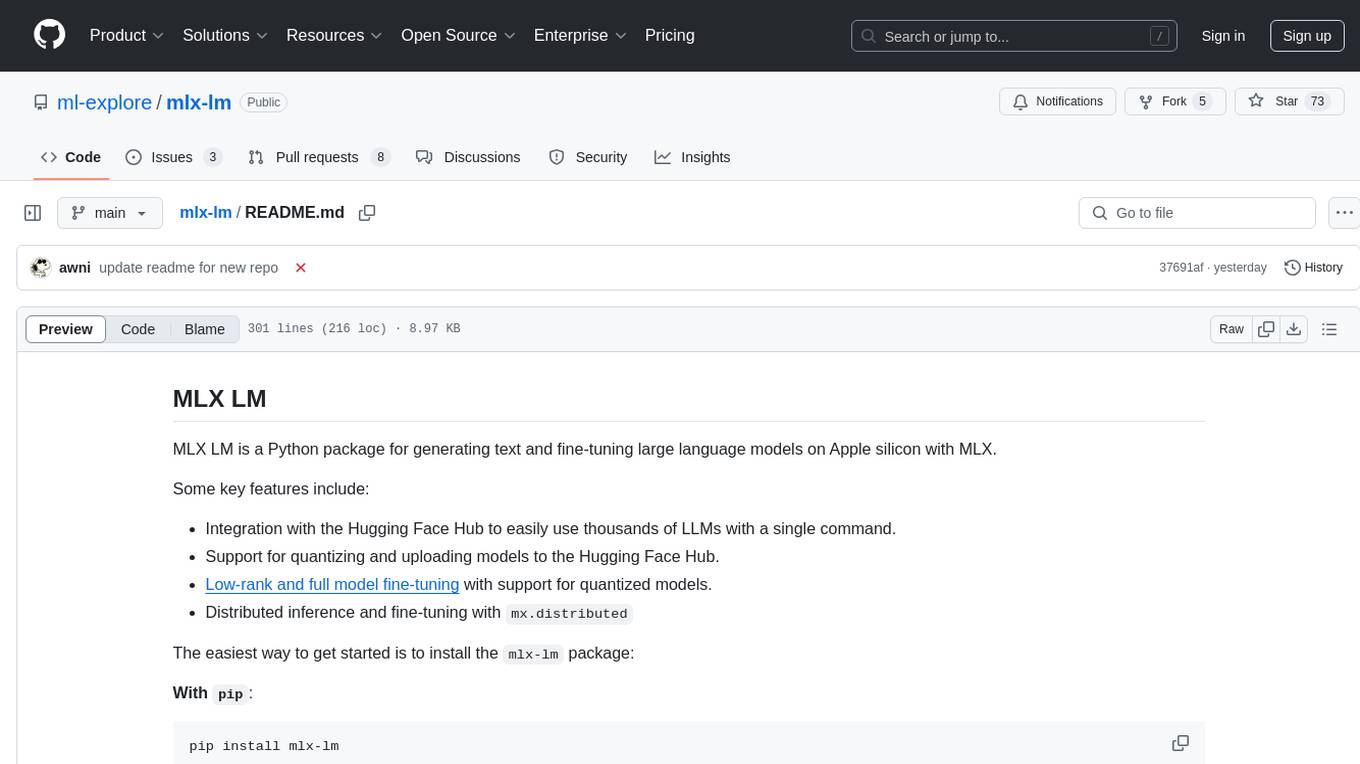
mlx-lm
MLX LM is a Python package designed for generating text and fine-tuning large language models on Apple silicon using MLX. It offers integration with the Hugging Face Hub for easy access to thousands of LLMs, support for quantizing and uploading models to the Hub, low-rank and full model fine-tuning capabilities, and distributed inference and fine-tuning with `mx.distributed`. Users can interact with the package through command line options or the Python API, enabling tasks such as text generation, chatting with language models, model conversion, streaming generation, and sampling. MLX LM supports various Hugging Face models and provides tools for efficient scaling to long prompts and generations, including a rotating key-value cache and prompt caching. It requires macOS 15.0 or higher for optimal performance.
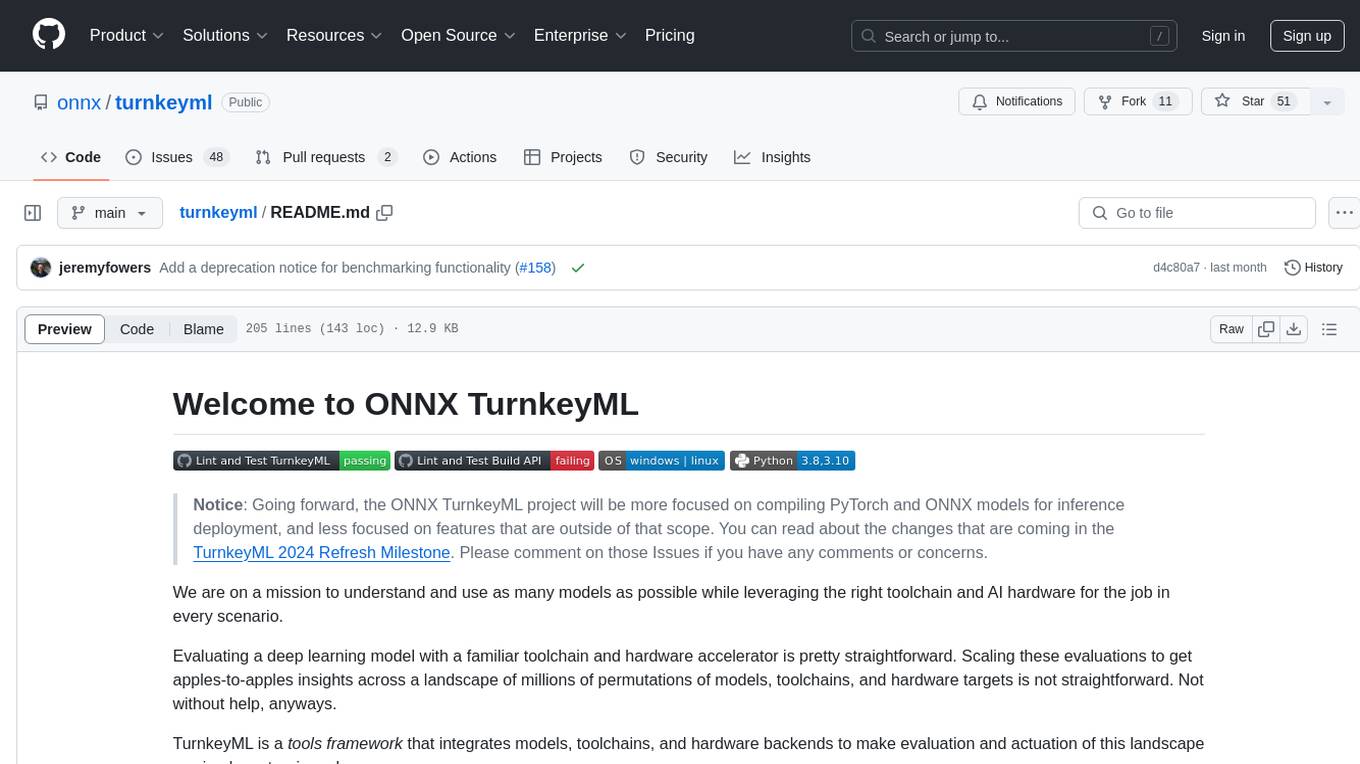
turnkeyml
TurnkeyML is a tools framework that integrates models, toolchains, and hardware backends to simplify the evaluation and actuation of deep learning models. It supports use cases like exporting ONNX files, performance validation, functional coverage measurement, stress testing, and model insights analysis. The framework consists of analysis, build, runtime, reporting tools, and a models corpus, seamlessly integrated to provide comprehensive functionality with simple commands. Extensible through plugins, it offers support for various export and optimization tools and AI runtimes. The project is actively seeking collaborators and is licensed under Apache 2.0.
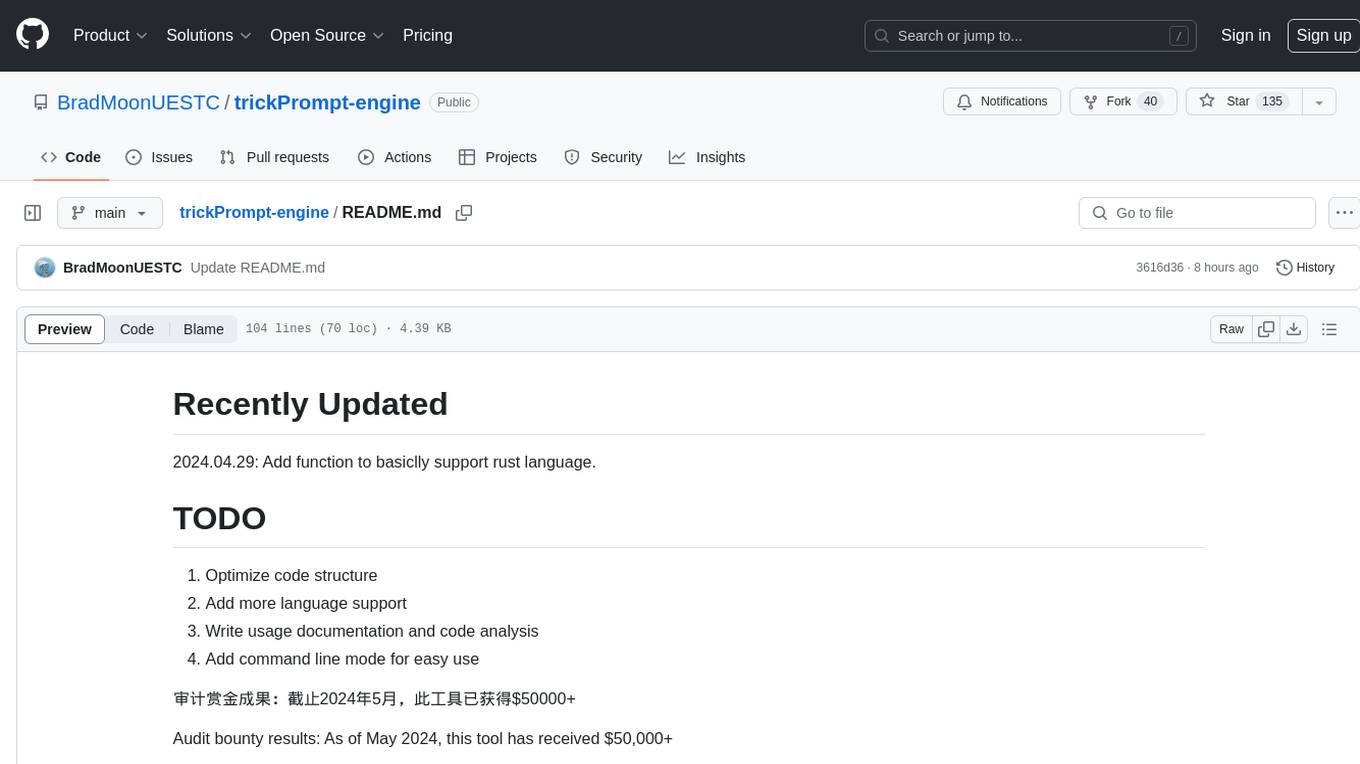
trickPrompt-engine
This repository contains a vulnerability mining engine based on GPT technology. The engine is designed to identify logic vulnerabilities in code by utilizing task-driven prompts. It does not require prior knowledge or fine-tuning and focuses on prompt design rather than model design. The tool is effective in real-world projects and should not be used for academic vulnerability testing. It supports scanning projects in various languages, with current support for Solidity. The engine is configured through prompts and environment settings, enabling users to scan for vulnerabilities in their codebase. Future updates aim to optimize code structure, add more language support, and enhance usability through command line mode. The tool has received a significant audit bounty of $50,000+ as of May 2024.
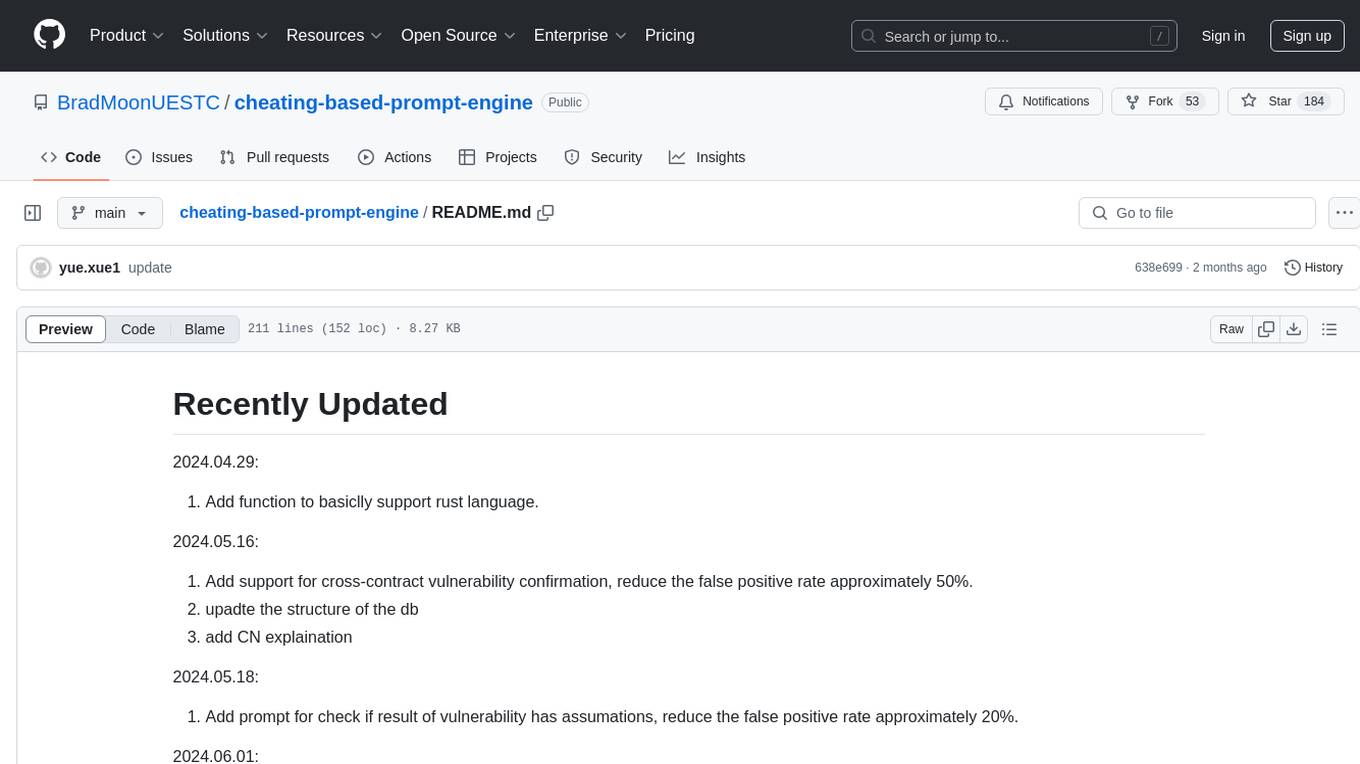
cheating-based-prompt-engine
This is a vulnerability mining engine purely based on GPT, requiring no prior knowledge base, no fine-tuning, yet its effectiveness can overwhelmingly surpass most of the current related research. The core idea revolves around being task-driven, not question-driven, driven by prompts, not by code, and focused on prompt design, not model design. The essence is encapsulated in one word: deception. It is a type of code understanding logic vulnerability mining that fully stimulates the capabilities of GPT, suitable for real actual projects.
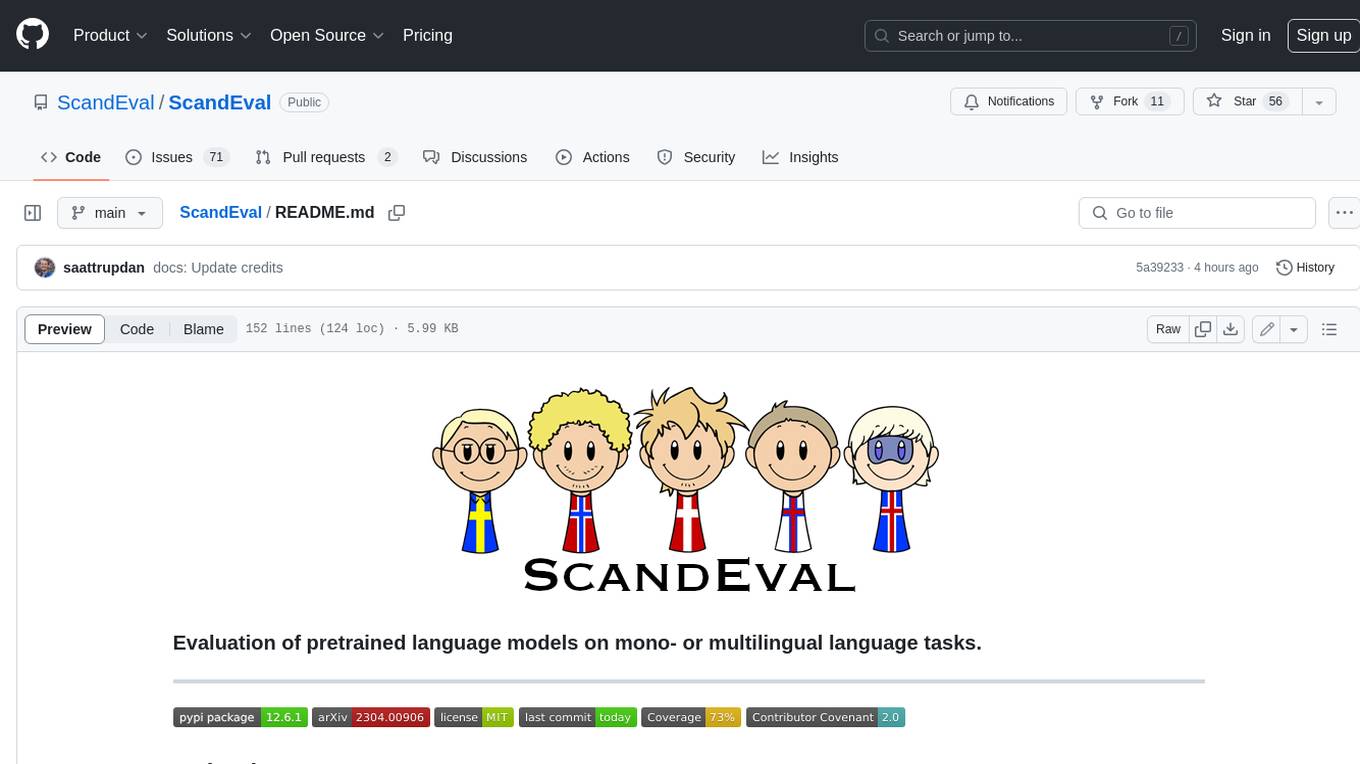
ScandEval
ScandEval is a framework for evaluating pretrained language models on mono- or multilingual language tasks. It provides a unified interface for benchmarking models on a variety of tasks, including sentiment analysis, question answering, and machine translation. ScandEval is designed to be easy to use and extensible, making it a valuable tool for researchers and practitioners alike.
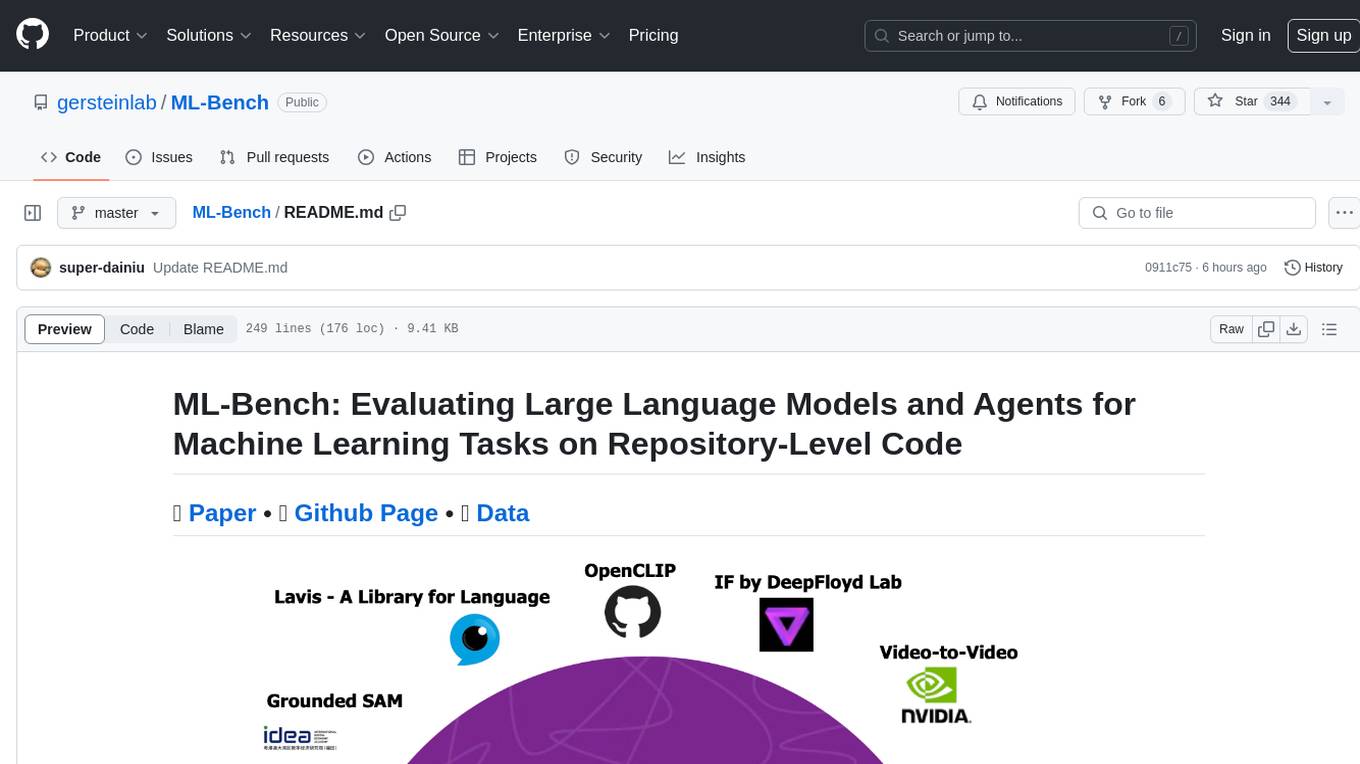
ML-Bench
ML-Bench is a tool designed to evaluate large language models and agents for machine learning tasks on repository-level code. It provides functionalities for data preparation, environment setup, usage, API calling, open source model fine-tuning, and inference. Users can clone the repository, load datasets, run ML-LLM-Bench, prepare data, fine-tune models, and perform inference tasks. The tool aims to facilitate the evaluation of language models and agents in the context of machine learning tasks on code repositories.
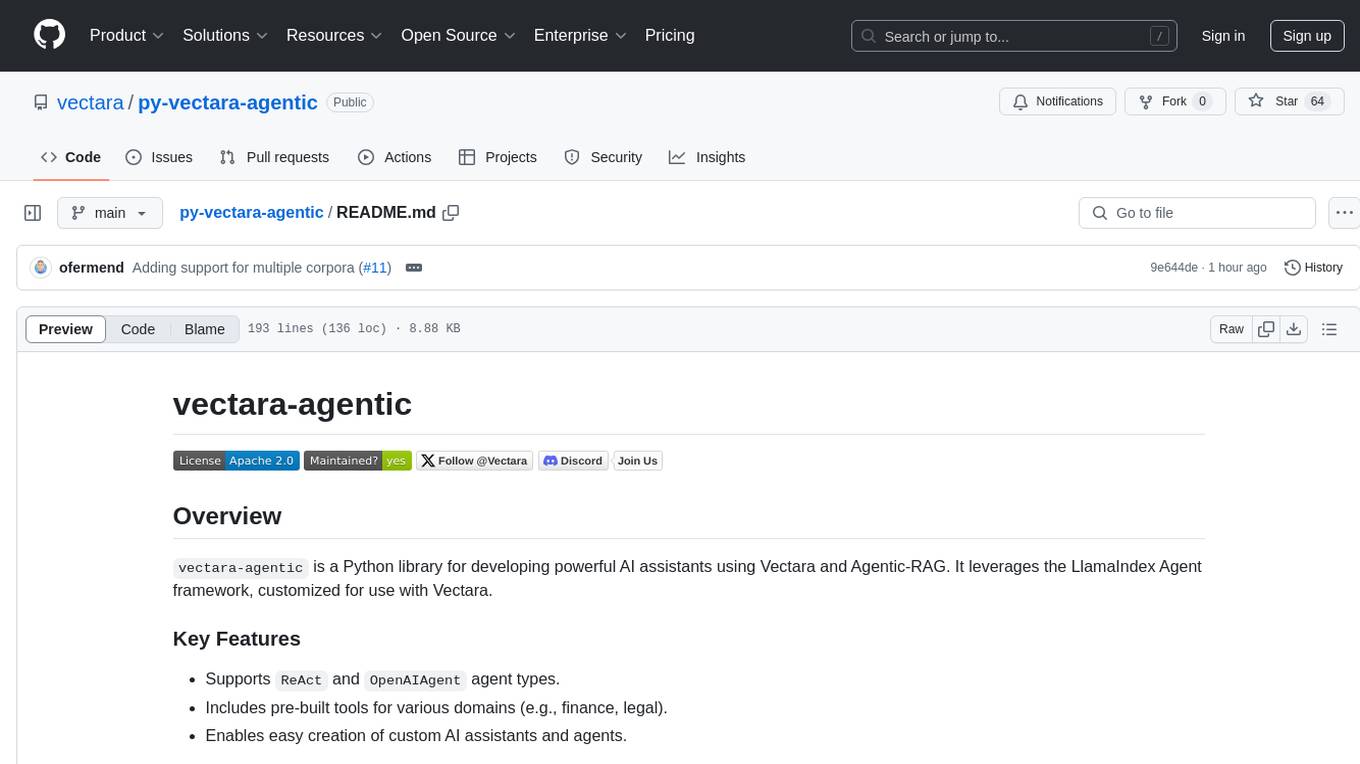
py-vectara-agentic
The `vectara-agentic` Python library is designed for developing powerful AI assistants using Vectara and Agentic-RAG. It supports various agent types, includes pre-built tools for domains like finance and legal, and enables easy creation of custom AI assistants and agents. The library provides tools for summarizing text, rephrasing text, legal tasks like summarizing legal text and critiquing as a judge, financial tasks like analyzing balance sheets and income statements, and database tools for inspecting and querying databases. It also supports observability via LlamaIndex and Arize Phoenix integration.
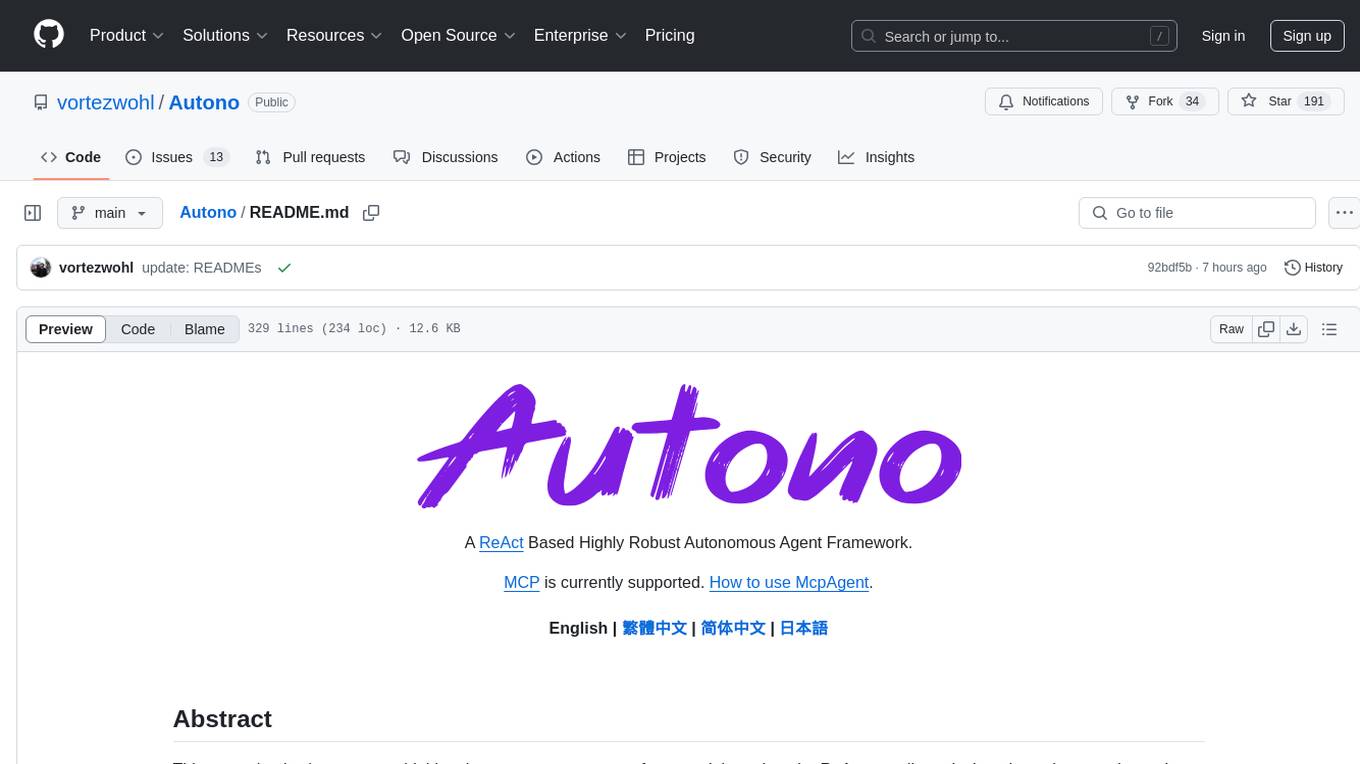
Autono
A highly robust autonomous agent framework based on the ReAct paradigm, designed for adaptive decision making and multi-agent collaboration. It dynamically generates next actions during agent execution, enhancing robustness. Features a timely abandonment strategy and memory transfer mechanism for multi-agent collaboration. The framework allows developers to balance conservative and exploratory tendencies in agent execution strategies, improving adaptability and task execution efficiency in complex environments. Supports external tool integration, modular design, and MCP protocol compatibility for flexible action space expansion. Multi-agent collaboration mechanism enables agents to focus on specific task components, improving execution efficiency and quality.
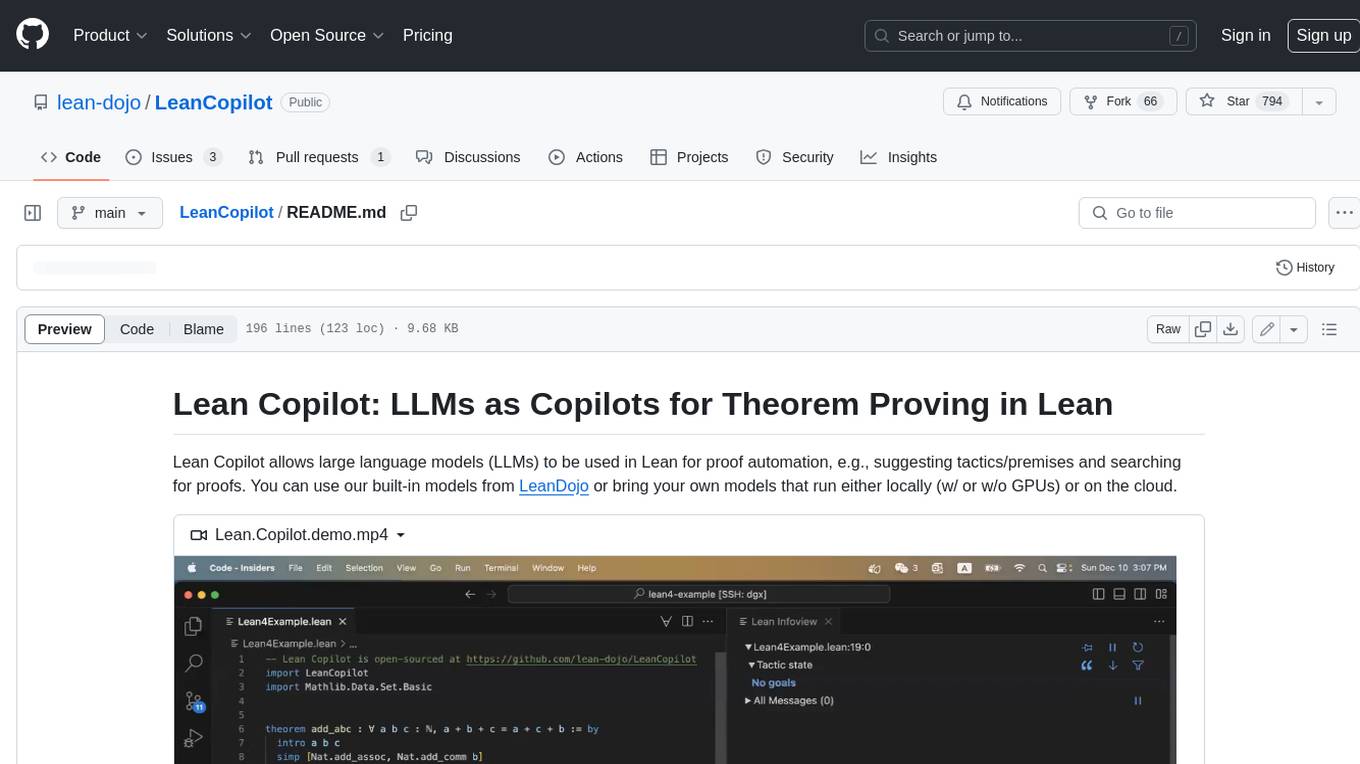
LeanCopilot
Lean Copilot is a tool that enables the use of large language models (LLMs) in Lean for proof automation. It provides features such as suggesting tactics/premises, searching for proofs, and running inference of LLMs. Users can utilize built-in models from LeanDojo or bring their own models to run locally or on the cloud. The tool supports platforms like Linux, macOS, and Windows WSL, with optional CUDA and cuDNN for GPU acceleration. Advanced users can customize behavior using Tactic APIs and Model APIs. Lean Copilot also allows users to bring their own models through ExternalGenerator or ExternalEncoder. The tool comes with caveats such as occasional crashes and issues with premise selection and proof search. Users can get in touch through GitHub Discussions for questions, bug reports, feature requests, and suggestions. The tool is designed to enhance theorem proving in Lean using LLMs.
For similar tasks

alignment-attribution-code
This repository provides an original implementation of Assessing the Brittleness of Safety Alignment via Pruning and Low-Rank Modifications. It includes tools for neuron-level pruning, pruning based on set difference, Wanda/SNIP score dumping, rank-level pruning, and rank removal with orthogonal projection. Users can specify parameters like prune method, datasets, sparsity ratio, model, and save location to evaluate and modify neural networks for safety alignment.
For similar jobs
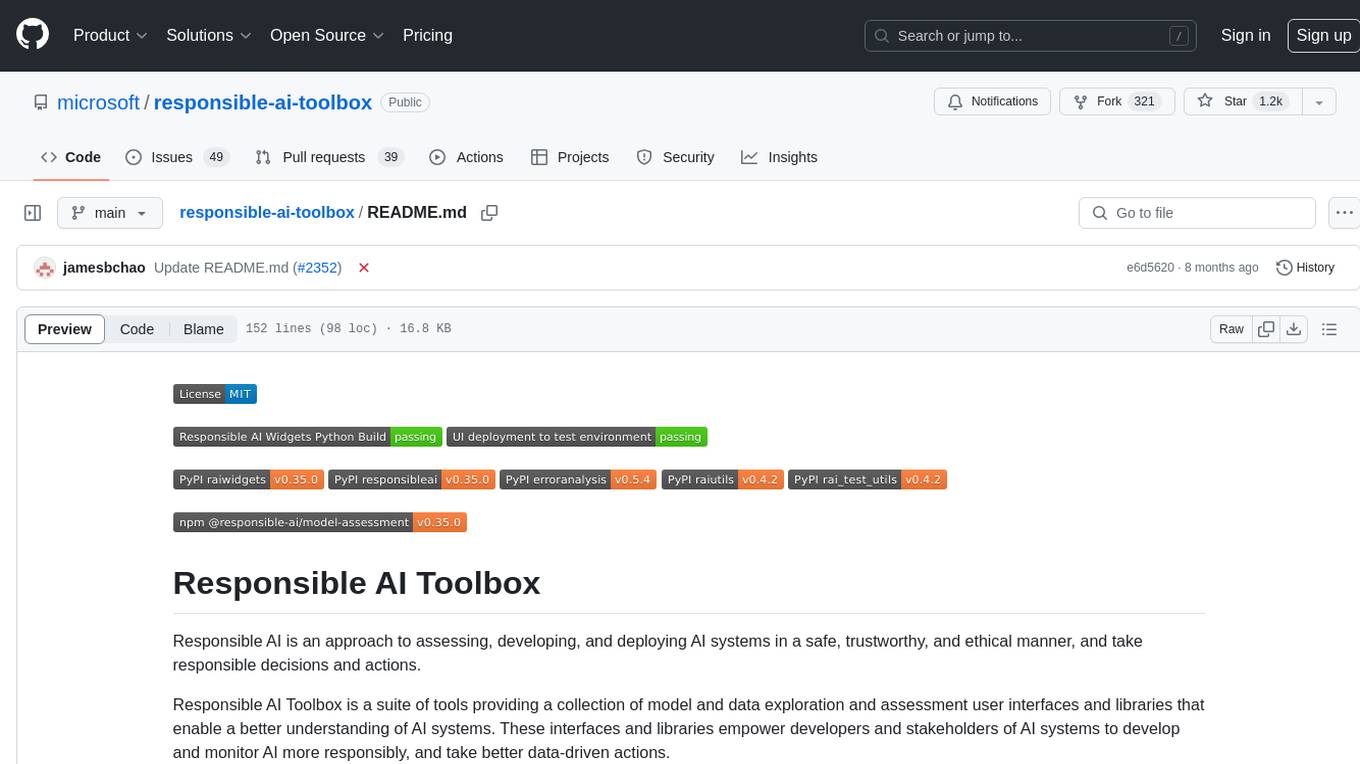
responsible-ai-toolbox
Responsible AI Toolbox is a suite of tools providing model and data exploration and assessment interfaces and libraries for understanding AI systems. It empowers developers and stakeholders to develop and monitor AI responsibly, enabling better data-driven actions. The toolbox includes visualization widgets for model assessment, error analysis, interpretability, fairness assessment, and mitigations library. It also offers a JupyterLab extension for managing machine learning experiments and a library for measuring gender bias in NLP datasets.
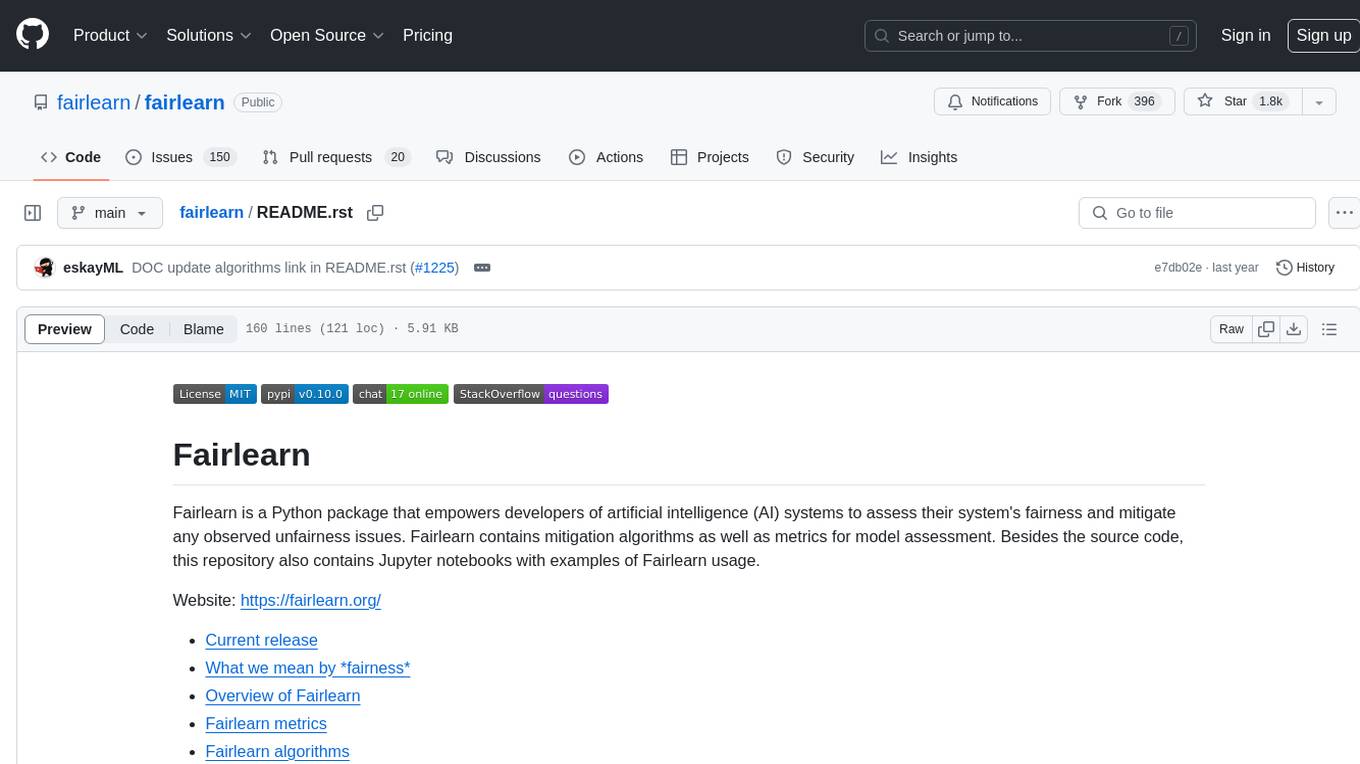
fairlearn
Fairlearn is a Python package designed to help developers assess and mitigate fairness issues in artificial intelligence (AI) systems. It provides mitigation algorithms and metrics for model assessment. Fairlearn focuses on two types of harms: allocation harms and quality-of-service harms. The package follows the group fairness approach, aiming to identify groups at risk of experiencing harms and ensuring comparable behavior across these groups. Fairlearn consists of metrics for assessing model impacts and algorithms for mitigating unfairness in various AI tasks under different fairness definitions.
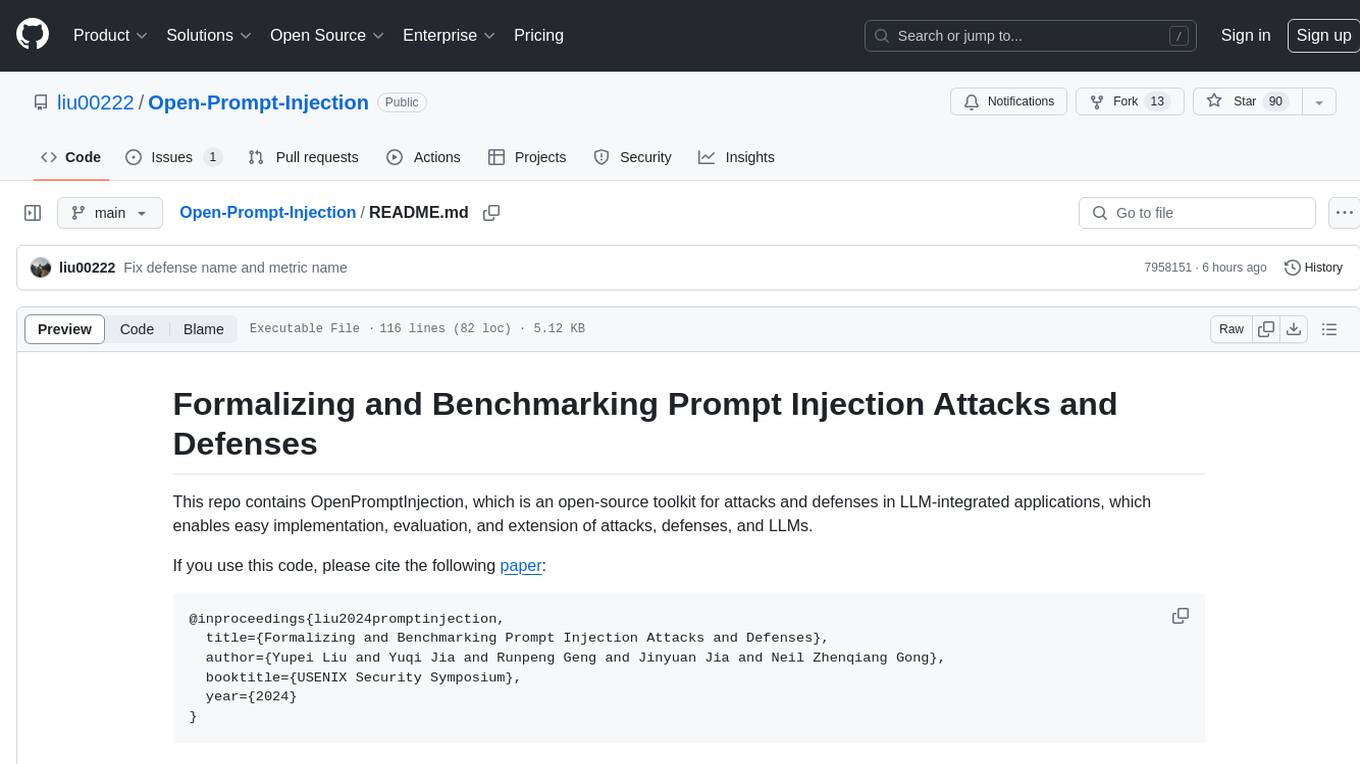
Open-Prompt-Injection
OpenPromptInjection is an open-source toolkit for attacks and defenses in LLM-integrated applications, enabling easy implementation, evaluation, and extension of attacks, defenses, and LLMs. It supports various attack and defense strategies, including prompt injection, paraphrasing, retokenization, data prompt isolation, instructional prevention, sandwich prevention, perplexity-based detection, LLM-based detection, response-based detection, and know-answer detection. Users can create models, tasks, and apps to evaluate different scenarios. The toolkit currently supports PaLM2 and provides a demo for querying models with prompts. Users can also evaluate ASV for different scenarios by injecting tasks and querying models with attacked data prompts.
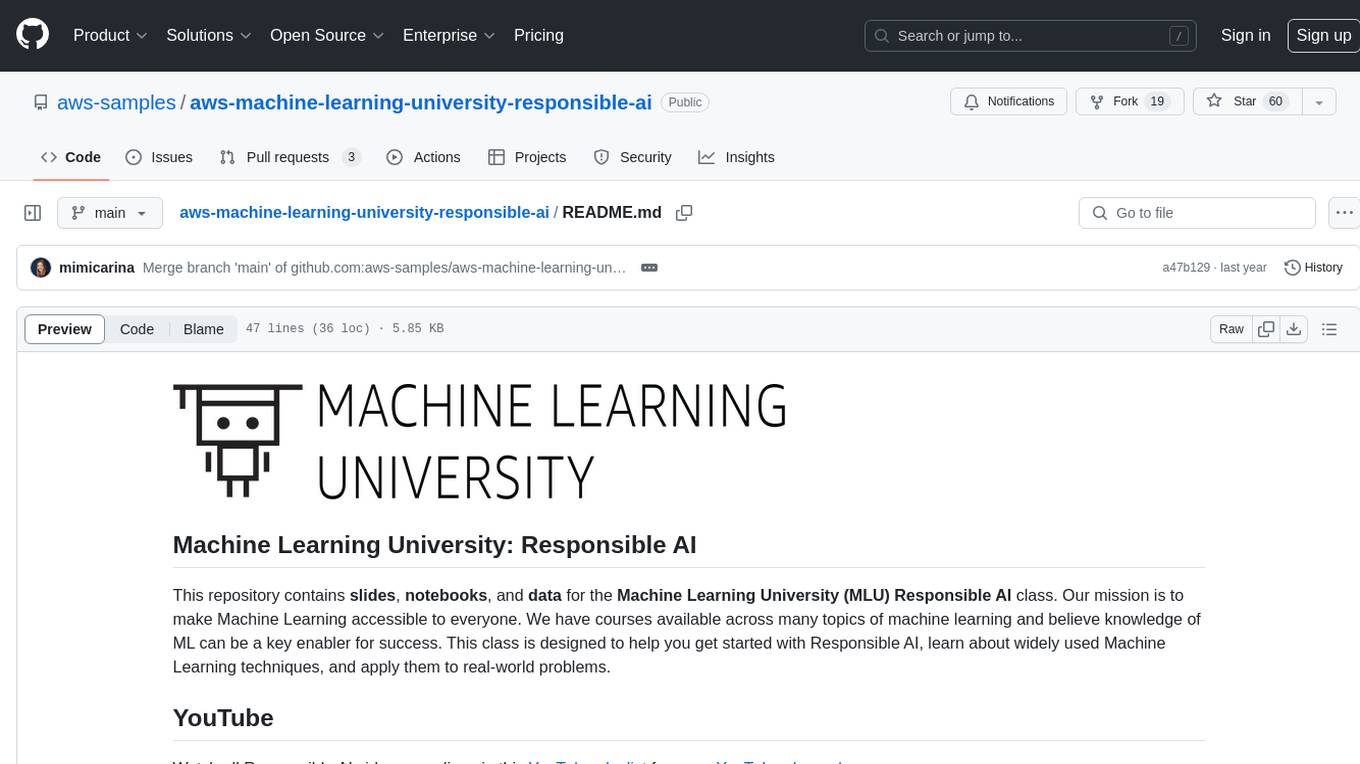
aws-machine-learning-university-responsible-ai
This repository contains slides, notebooks, and data for the Machine Learning University (MLU) Responsible AI class. The mission is to make Machine Learning accessible to everyone, covering widely used ML techniques and applying them to real-world problems. The class includes lectures, final projects, and interactive visuals to help users learn about Responsible AI and core ML concepts.
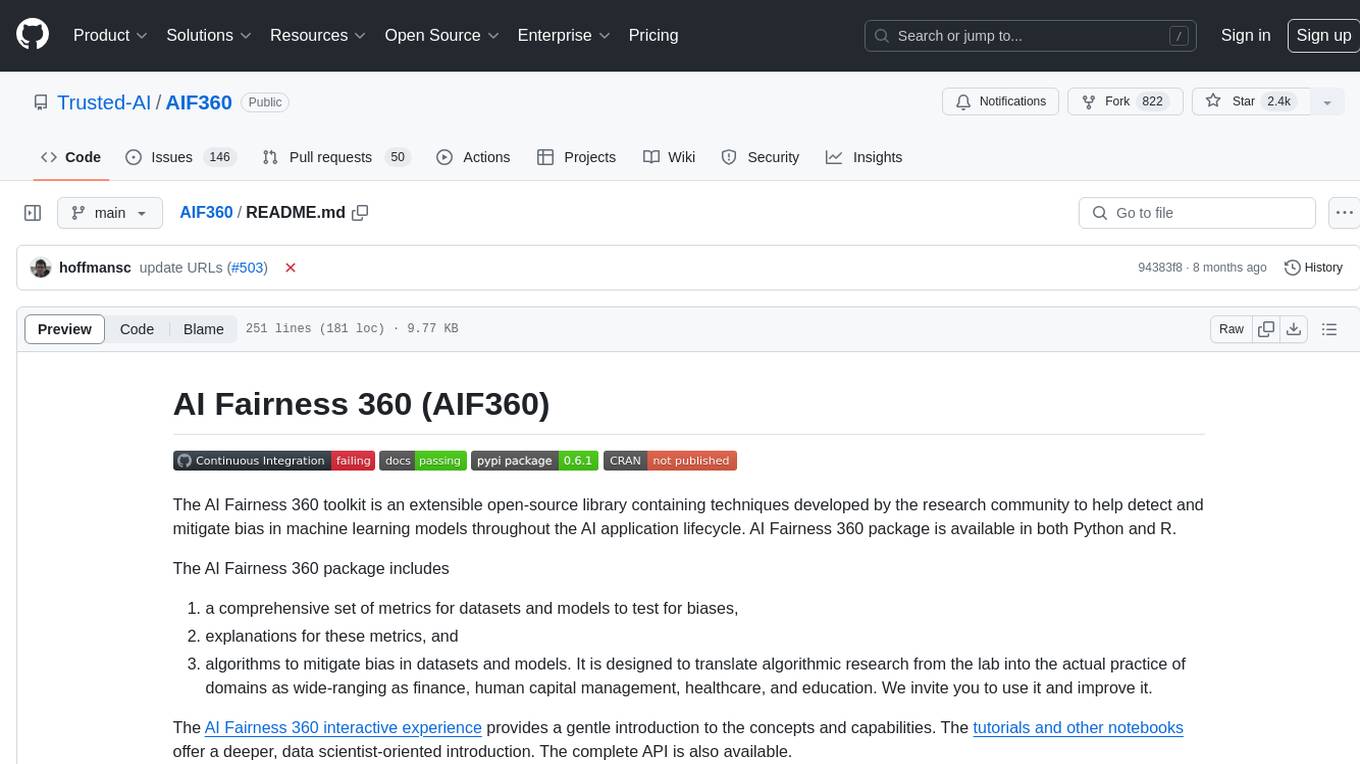
AIF360
The AI Fairness 360 toolkit is an open-source library designed to detect and mitigate bias in machine learning models. It provides a comprehensive set of metrics, explanations, and algorithms for bias mitigation in various domains such as finance, healthcare, and education. The toolkit supports multiple bias mitigation algorithms and fairness metrics, and is available in both Python and R. Users can leverage the toolkit to ensure fairness in AI applications and contribute to its development for extensibility.
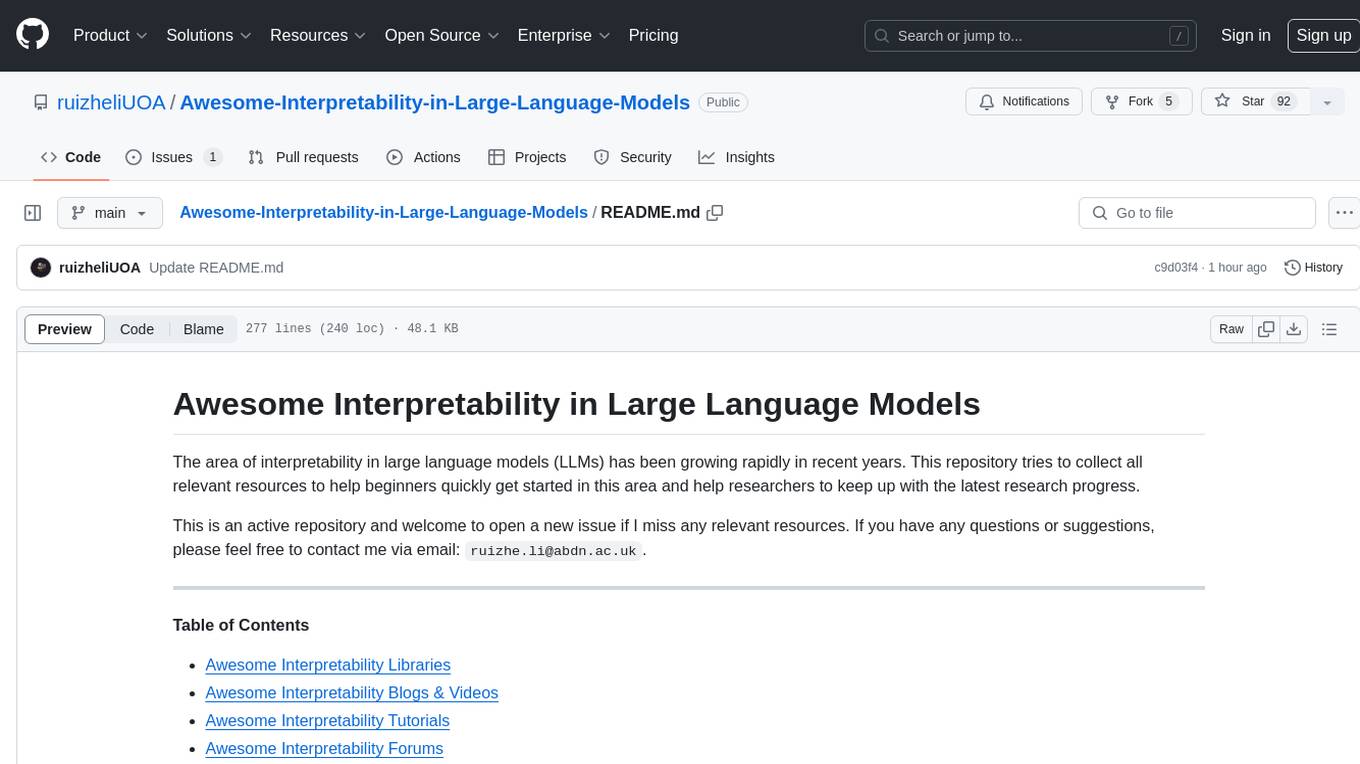
Awesome-Interpretability-in-Large-Language-Models
This repository is a collection of resources focused on interpretability in large language models (LLMs). It aims to help beginners get started in the area and keep researchers updated on the latest progress. It includes libraries, blogs, tutorials, forums, tools, programs, papers, and more related to interpretability in LLMs.
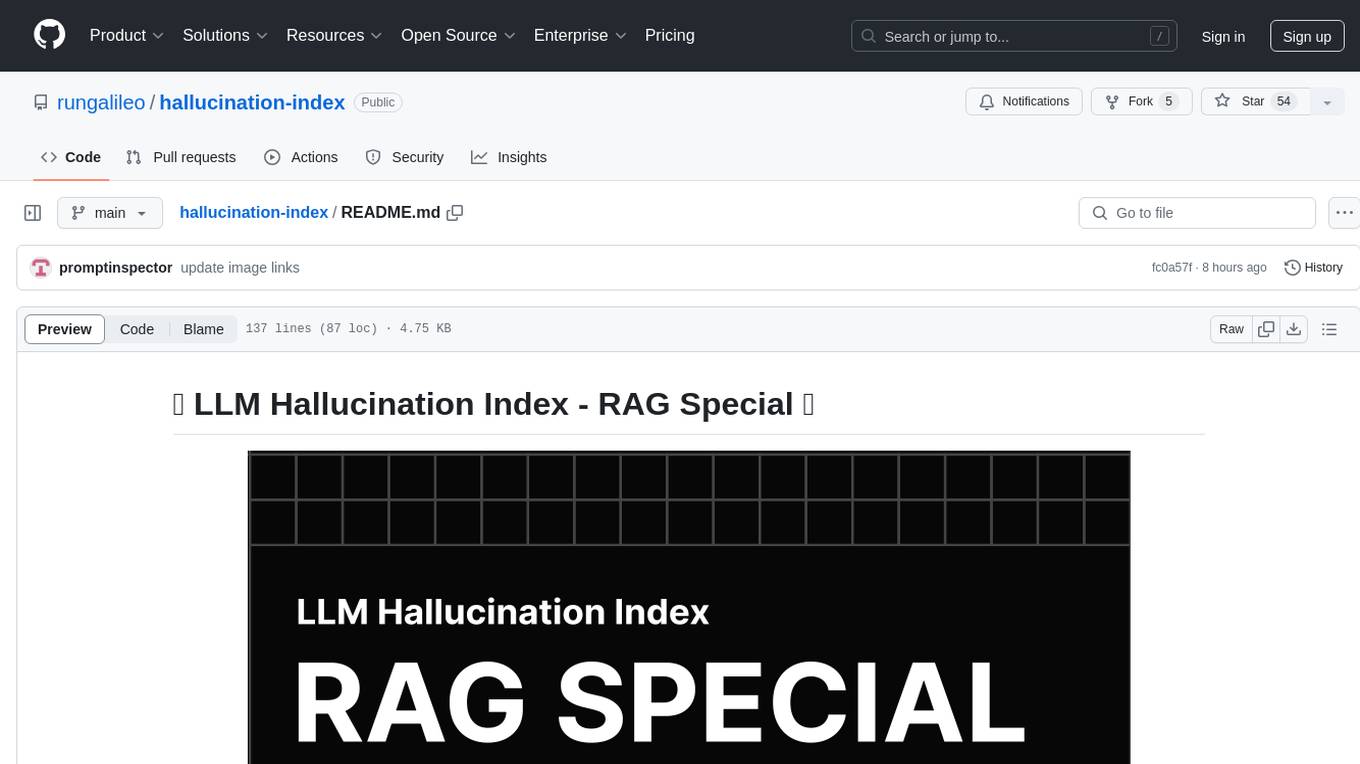
hallucination-index
LLM Hallucination Index - RAG Special is a comprehensive evaluation of large language models (LLMs) focusing on context length and open vs. closed-source attributes. The index explores the impact of context length on model performance and tests the assumption that closed-source LLMs outperform open-source ones. It also investigates the effectiveness of prompting techniques like Chain-of-Note across different context lengths. The evaluation includes 22 models from various brands, analyzing major trends and declaring overall winners based on short, medium, and long context insights. Methodologies involve rigorous testing with different context lengths and prompting techniques to assess models' abilities in handling extensive texts and detecting hallucinations.
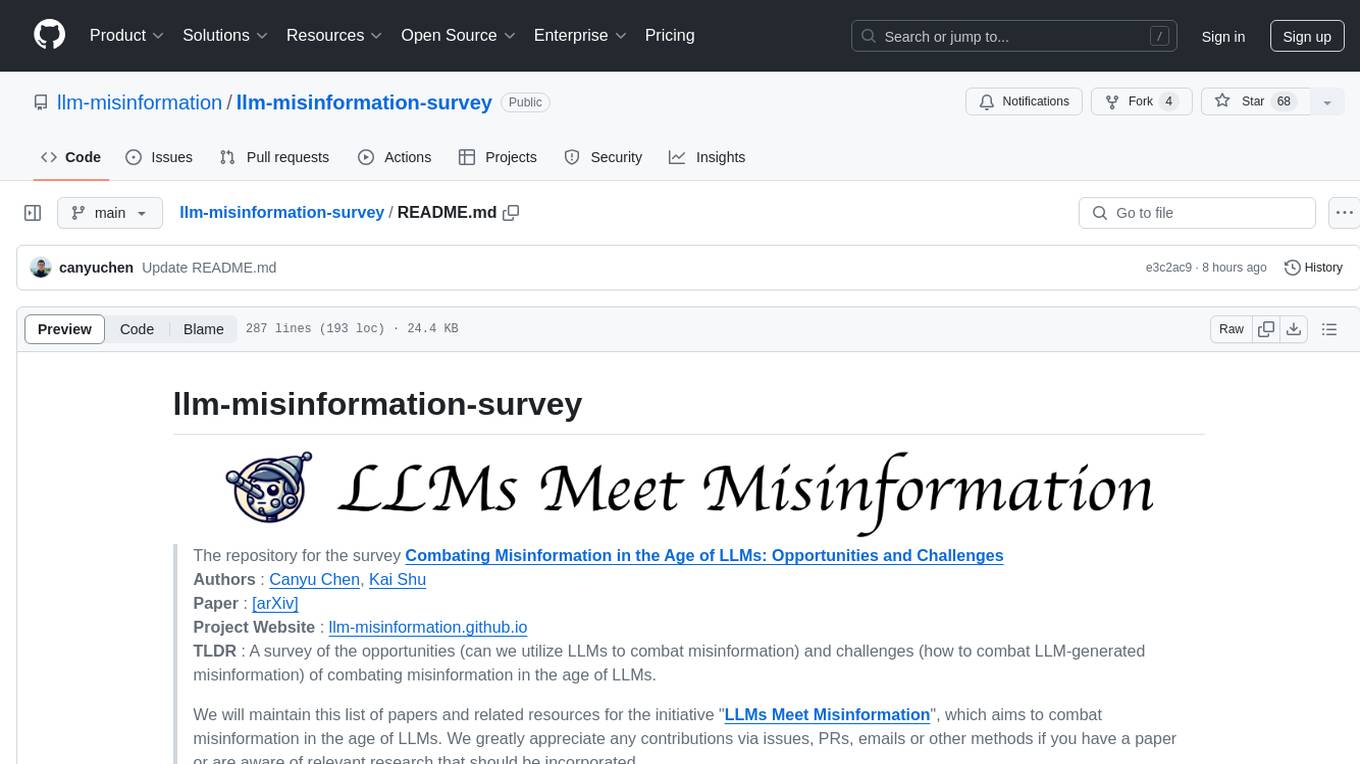
llm-misinformation-survey
The 'llm-misinformation-survey' repository is dedicated to the survey on combating misinformation in the age of Large Language Models (LLMs). It explores the opportunities and challenges of utilizing LLMs to combat misinformation, providing insights into the history of combating misinformation, current efforts, and future outlook. The repository serves as a resource hub for the initiative 'LLMs Meet Misinformation' and welcomes contributions of relevant research papers and resources. The goal is to facilitate interdisciplinary efforts in combating LLM-generated misinformation and promoting the responsible use of LLMs in fighting misinformation.